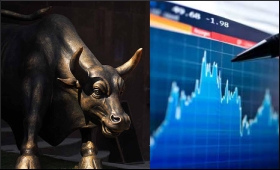|

|
Bond market's take on Indian election outcome
|
|

|
|
| Top Stories |
 |
|
|
|
Vatsal Srivastava | 25 Apr, 2014
As the world's largest democracy braces itself for the results of the ongoing general elections, due May 16, Indian equities already seem to be pricing in the verdict of the nation's 1.3 billion people. This, on expectations that Narendra Modi, the prime ministerial candidate of the main opposition party, the BJP, will head the next federal government.
The benchmark equity index, Nifty, has rallied more than 14 percent to an all-time high since early February. Although, the market is at all-time nominal highs, in inflation adjusted terms we are still below the pre-credit-crisis levels unlike equity indices in the West such as the S&P 500 and the German DAX.
Till recently, the move-up was largely driven by bluechip stocks. It is only in the past few weeks of this "pre-election rally" that we have seen money being churned out of IT and pharma names into beaten down infrastructure and financial stocks.
The mood is supremely bullish in the equities market and the common joke doing the rounds on Dalal Street is that the fair value of the Sensex is the number of seats secured by the NDA multiplied by 100.
At this juncture, it would be unwise to be a contrarian and not place bullish bets. If the next government is, indeed, successful in reviving the investment cycle, we could very well find ourselves in the midst of a new secular bull market.
The swiftness with which the anticipated next National Democratic Alliance (NDA) government will introduce policy reforms will only be seen in the coming months. But one must also keep a close watch on how the bond market has been behaving in the run-up to the election results.
Looking through the prism of another asset class in the prevailing bullish market, the context tells a different story. There has been a stark divergence in the performance of bonds versus equities. The yield on the 10-year benchmark Treasury bond is hovering around 9 percent, only half-percentage-point away from a 10-year high.
The bond market, it seems, is still not buying the "Modi rally". Concerns still loom over prices (recent retail inflation data saw an unexpected uptick) and the sustainability of the correction in the fiscal deficit.
JP Morgan has correctly pointed out in a recent report: "It is difficult to envisage a situation where growth revives meaningfully, driven by the investment cycle, with the Government of India borrowing long-term funds at interest rates in excess of 9 percent. Over the past, restrictive monetary policy and elevated treasury yields have coincided with growth moderation and have not been supportive of equity market performance. This underpins the relative attraction of bonds, particularly adjusted for risk."
Thus, as the report points out, either the bond market can join the rally on expectations of an improved macro outlook or the equities will eventually correct as investors shed their enthusiasm if corporate earnings do not justify the recent multiple expansion.
Historically, according to JP Morgan, long bonds seem to be more attractively valued than equities. The ratio of the 10-year yield to the earnings yield is now close to 1:4. According to this historical valuation metric, equities are now in an overvalued zone.
This ratio was higher than the current level only at the peak of the credit crisis of 2008. According to JP Morgan analysts, this relative valuation favouring debt holds good for the five-year and one-year bonds as well.
The price action in the bond market points out that equities may have over stretched themselves in the short-term. But there is no near-term catalyst that would prompt an immediate sell off - unless the BJP's tally is far worse than the current projections on May 16. This is not the time to fight the upward momentum and every dip in Indian equities should be used as a buying opportunity for the near-term.
|
|
|
| |
|
|
|
|
|
|
|
|
|
|
|
|
|
|
| |
| Customs Exchange Rates |
| Currency |
Import |
Export |
US Dollar
|
66.20
|
64.50 |
UK Pound
|
87.50
|
84.65 |
Euro
|
78.25
|
75.65 |
| Japanese
Yen |
58.85 |
56.85 |
| As on 13 Aug, 2022 |
|
|
| Daily Poll |
 |
 |
| PM Modi's recent US visit to redefine India-US bilateral relations |
|
|
|
|
|
| Commented Stories |
 |
|
|
|
|
|
| |
|